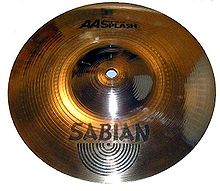Cymbal
- This article is about the percussion instruments made of metal disks. For the string instrument played with beaters see cymbalum.

Cymbals (Fr. cymbales; Ger. Becken; Ital. piatti or cinelli; Por. pratos), are a modern percussion instrument. Cymbals consist of thin, normally round plates of various cymbal alloys; see cymbal making for a discussion of their manufacture. Most modern cymbals are of indefinite pitch (tuned sets have been manufactured but are rare), whereas small cup-shaped cymbals based on ancient designs sound a definite note (see: crotales).
Cymbals are used in modern orchestras and many military, marching, concert and other bands. They are one of the two instrument types that form the modern drum kit, the other of course being the drum, and as such are a basic part of much contemporary music. Even the most basic drum kit normally contains at least one suspended cymbal and a pair of hi-hat cymbals.
Orchestral cymbals
Although cymbals are not often required they form part of every orchestra; their chief use is for marking the rhythm and for producing weird, fantastic effects or adding military colour, and their shrill notes hold their own against a full orchestra playing fortissimo. Cymbals are specially suited for suggesting frenzy, fury or bacchanalian revels, as in the Venus music in Wagner's Tannhäuser and Grieg's Peer Gynt suite.
Crash cymbals

Orchestral crash cymbals are traditionally used in pairs, each one having a strap set in the bell of the cymbal by which they are held. Such a pair is known technically as a pair of clash cymbals, although this term is rarely used, see clash cymbals. They are confusingly sometimes referred to simply as crash cymbals, although this term properly applies also to some suspended cymbals.
The sound can be obtained by rubbing their edges together in a sliding movement for a "sizzle", striking them against each other in what is called a "crash", tapping the edge of one against the body of the other in what is called a "tap-crash", scraping the edge of one from the inside of the bell to the edge for a "scrape," or shutting the cymbals together and choking the sound in what is called a "hi-hat chick." A skilled player can obtain an enormous dynamic range from such a pair of cymbals. For example, in Beethoven's ninth symphony, one of their first appearances in an orchestral work, they make their entry pianissimo, adding a touch of colour rather than an almighty crash.
Clash cymbals are usually damped by pressing them against the player's body. A composer may write laissez vibrer, "Let them vibrate" (usually l.v.), sec (dry), or equivalent indications on the score; more usually, the player must judge exactly when to damp the cymbals based on the written duration of crash and the context in which it occurs.
Clash cymbals have traditionally been accompanied by the bass drum playing an identical part. This combination, played loudly, is an effective way to accentuate a note since the two instruments together contribute to both very low and very high frequency ranges and provide a satisfying "crash-bang-wallop". In older music the composer sometimes provided just one part for this pair of instruments, writing senza piatti or piatti soli (Italian: "without cymbals" or "cymbals only") if the bass drum is to remain silent. However, the modern convention is for the instruments to have independent parts.
Clash cymbals evolved into the low-sock and from this to the modern hi-hat. Even in a modern drum kit, they remain paired with the bass drum as the two instruments which are played with the player's feet. However, hi-hat cymbals tend to be heavy with little taper, more similar to a ride cymbal than to a crash cymbal as found in a drum kit, and perform a ride rather than a crash function.
Suspended cymbal
The second main orchestral use of cymbals is the suspended cymbal. This instrument takes its name from the traditional method of suspending the cymbal by means of a leather strap or rope, thus allowing the cymbal to vibrate as freely as possible for maximum musical effect. Early jazz drumming pioneers borrowed this style of cymbal mounting during the early 1900's and later drummers further developed this instrument in to the mounted horizontal or nearly horizontally mounted "crash" cymbals of a modern drum kit.
Suspended cymbals are most often played with yarn wrapped mallets. However, some composers request other types of mallets like felt mallets or timpani beaters for different attack and sustain qualities. Suspended cymbals can produce bright and slicing tones when forcefully struck, and give an eerie transparent "windy" sound when played quietly. A tremolo, or roll (played with two mallets alternately striking on opposing sides of the cymbal) can build in volume from almost inaudible to an overwhelming climax in a satisfyingly smooth manner (as in Humperdink's Mother Goose Suite).
Furthermore, the edge of a suspended cymbal may be hit with shoulder of a drum stick to obtain a sound somewhat akin to that of a pair of clash cymbals. Other methods of playing include scraping a coin or a triangle beater rapidly across the ridges on the top of the cymbal, giving a "zing" sound (as in the fourth movement of Dvořák's Symphony No. 9). Other effects that can be used include drawing a cello or bass bow across the edge of the cymbal for a sound not unlike squealing car brakes.
Cymbals may also be dropped, intentionally or otherwise, causing a range of sounds depending on whether it hits the floor full on or spins before coming to a rest. This is not particularly good for the cymbal, however.
Ancient cymbals
Ancient cymbals or tuned cymbals are much more rarely called for. Their timbre is entirely different, more like that of small hand-bells or of the notes of the keyed harmonica. They are not struck full against each other, but by one of their edges, and the note given in by them is higher in proportion as they are thicker and smaller. Berlioz's Romeo and Juliet calls for two pairs of cymbals, modelled on some old Pompeian instruments no larger than the hand (some are no larger than a crown piece), and tuned to F and B flat. The modern instruments descended from this line are the crotales.
Origins
The origins of cymbals can be traced back to prehistoric times. The ancient Egyptian cymbals closely resembled our own. The British Museum possesses two pairs, thirteen centimetres in diameter, one of which was found in the coffin of the mummy of Ankhhape, a sacred musician. Those used by the Assyrians were both plate- and cup-shaped, those of the Ancient Persians large-sized plates, made of brass, known as Sanj. The Greek cymbals were cup- or bell-shaped, and may be seen in the hands of innumerable fauns and satyrs in sculptures and on painted vases. The word cymbal is derived from the Latin cymbalum, which itself derives from the Greek word kumbalom, meaning a small bowl.
Terminology
During the middle ages the word cymbal was applied to the Glockenspiel, or peal of small bells, and later to the dulcimer, perhaps on account of the clear bell-like tone produced by the hammers striking the wire strings. After the introduction of the keyed dulcimer or clavichord the spinet, the word clavicymbal was used in the Romance languages to denote the varieties of spinet and harpsichord. Ancient cymbals are among the instruments played by King David and his musicians in the 9th-century illuminated manuscript known as the Bible of Charles the Bald in the Bibliothèque Nationale, Paris.
Types of cymbals
Particular types of cymbals include:
- China cymbals
- Clash cymbals
- Crash cymbals
- Hi-hat cymbals
- Persian cymbals
- Ride cymbals
- Swish and pang cymbals
- Sizzle cymbals
- Splash cymbals
- Suspended cymbals
- Finger cymbals
See also
Manufacturers
- Ajaha
- Avedis Zildjian Company
- Bosphorus
- Istanbul
- Italian Bellotti Cymbals
- Sabian
- Saluda
- Meinl
- Paiste
- UFIP
- Wuhan
See also Category:Cymbal manufacturers. lalalalalalala
External links
- Orchestral cymbal playing, with an excellent short history of cymbals
References
- This article incorporates text from a publication now in the public domain: Chisholm, Hugh, ed. (1911). Encyclopædia Britannica (11th ed.). Cambridge University Press.
{{cite encyclopedia}}: Missing or empty|title=(help)
